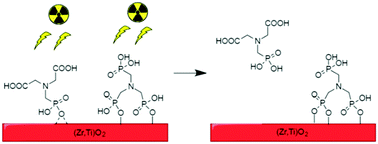New insights into the radiolytic stability of metal(iv) phosphonate hybrid adsorbent materials†
Abstract
Stable metal(IV) phosphonate hybrids are a promising class of materials for the critical issue of nuclear waste cleanup. However, to be of practical use, adsorbent materials must demonstrate radiolytic stability and this property remains poorly understood. Therefore, the radiolytic stabilities of post-functionalised mesoporous zirconium titanate and zirconium phosphonate coordination polymers were compared. For the first time, solid-state 31P MAS-NMR was used to probe the radiolytic degradation of metal(IV) phosphonates and provide mechanistic insight. Polyphosphonate-functionalized hybrids were more stable than monophosphonate hybrids, as the monophosphonate readily detached from the oxide surface. The zirconium phosphonate coordination polymer (Zr-ATMP) demonstrated the greatest radiolytic stability, attributed to its high ligand loading and intimately mixed structure. Zr-ATMP maintained highly efficient sorption from strongly acidic solutions even after receiving doses of gamma radiation up to 2.9 MGy.

- This article is part of the themed collection: 2020 PCCP HOT Articles


 Please wait while we load your content...
Please wait while we load your content...